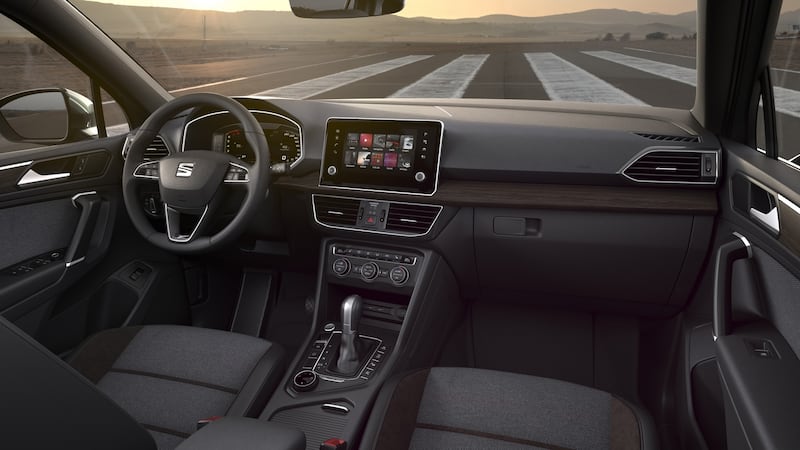Spanish car company Seat has revealed a new flagship SUV, the Tarraco. Available in five or seven configuration, while it's the biggest SUV on its books, it will still come it at a lower the company's Alhambra people carrier.
While the car was designed at Seat's headquarters at Martorell on the outskirts of Barcelona, it will be built in Germany alongside similar models from its fellow VW Group brands. This means the Tarraco will be built at Volkswagen's plant in Wolfsburg alongside the Skoda Kodiaq and Volkswagen Tiguan All Space.
While it strongly resembles its VW Group counterparts, the Tarraco arrives on the market at a time when Seat is repositioning itself as a more stylised and sporty affordable brand within the group.
Seat has about a three per cent market share in Ireland and over the last few years has become the value for money offering in the VW group's range. Skoda has more than double Seat's share of the market and it too has shifted to become a more mainstream brand and it's product range and prices reflect this. Seat this year will sell circa 3,700 cars and is relatively tiny in sales terms. In order to survive it has to deliver keen pricing.
There is a rumour of a Cupra performance version and it should raise the pulse rate of what otherwise looks like a well proportioned, nice family car. This would follow the arrival in January of the Cupra Ateca, the latest model of the company’s new sub-brand. The Cupra Ateca will have all wheel drive, 300hp and a circa €50,000 asking price.
The Tarraco uses VW’s big modular platform, called MQB-A. It means the SUV can have a long wheelbase. This big 2,790mm gap between the front and rear wheels has a couple of benefits to ride quality and interior layout. The most obvious benefit is the greater cabin space. The Tarraco is 4,735mm long and 1,658mm tall.
This compares to the Kodiaq’s 4,697mm and 1,676mm, Tiguan All Space at 4,701mm and 1,674mm and the Peugeot 5008’s 4,641mm and 1,646mm. Boot space at 760 litres is vast, especially in the five seater as there is additional under floor space where the extra two permanent folding seats of the seven seater version are be stowed. LED lights in a recognisable Seat triangular shape are standard and dominate the new look grille. Alloys, up to 20 inch in size, fill out the arches well and overall the Tarraco’s proportions are well thought out.

Inside, the cabin is impressive and a step up for the brand. An Audi-like 10.25-inch digital cockpit display feeds the driver key information while an 8-inch floating HMI screen delivers the usual connectivity and secondary controls displays from the centre of the dashboard. Gesture controls will be a feature with the optional navigation plus.
The Tarraco gets a number as standard such as lane assist and front assist including bicycle and pedestrian detection. Optional aids include BLIS blind spot detection, ACC adaptive cruise control and light assist. The Tarraco is also equipped with emergency call, pre-crash assist and rollover detection.
A VW group range of engines will power the Tarraco and include petrol and diesel power. Petrol TSI engines are four cylinder units with the entry a 1.5 litre, 150hp FWD and six speed manual and a range topping 2 litre, 190hp with a seven speed DSG automatic gearbox and 4Drive all wheel drive or as Seat calls it, total traction system. Diesel power comes from a 2 litre with a couple of power outputs; 150hp FWD (man/auto) and 190hp, 4Drive, automatic.
Pricing is yet to be released but we expect it should undercut the Skoda Kodiaq on a like for like basis. It starts from €30,950 (1.5 petrol) or from €37,175 for the diesel powered FWD 150hp.
In theory Seat’s new cars represents better value than the equivalent Volkswagen. Both company’s vehicles share a high percentage of parts and engines and there is very little difference between them. It’s one thing saying that and another in reality as people are picky and VW has a better known and more respected name. The Seat Ibiza, Arona and Ateca, for example, are excellent options in their own right. In percentage terms Seat’s growth is impressive, up 13.5 per cent over 2017 year to date. This is largely down to the Arona and Ateca, its small and compact SUVs, which so far this year make up 44 per cent of Seat’s Irish sales. The Tarraco adds another arrow to its quiver, and a timely one for the appetite for SUVs seems to grow every month.









